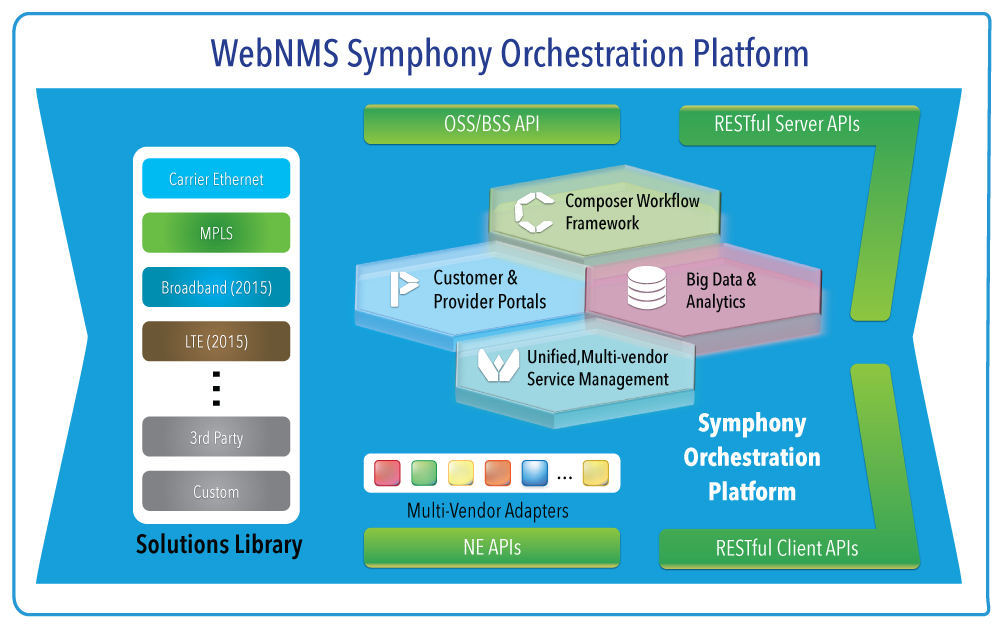- Providers look to transform NMS into orchestration
- Service providers see a $1T opportunity in the virtual services market, but realize they must increase their agility and reduce their OPEX to compete successfully.
In 2014, this realization began generating demand for increased automation of network operations, referred to as service orchestration. Service orchestration automates the operations that are currently controlled by network management software (NMS). WebNMS, which focuses on service provider NMS, released its Symphony Orchestration Platform in 2014, marking a milestone on the path to orchestration and signalling the WebNMS strategy in 2015.
NMS takes center stage
This transition from management to orchestration has focused a spotlight on NMS unlike anything the industry has seen before. NMS has long been an essential layer of network operations, converting requests from business layer OSS systems into services on multi-vendor network elements. Though essential, NMS has often been seen a translation layer, relying on process
intelligence captured in manual steps by network administrators. But now, with automated dynamic services seen as a critical factor for revenue growth, providers see this layer as the logical convergence point for network and service orchestration.
The industry has already seen evidence of this increased focus on NMS during the past year. Cisco acquired Tail-F, a multi-vendor NMS provider to bolster their network service orchestration capabilities. Recognizing the value, several other OEMs have announced orchestration products, some leveraging WebNMS technology. At the recent Metro Ethernet Forum GEN14 Conference, orchestration was a central element of every presentation at the Proof of Concept Showcase.
Investing in transformative technology
WebNMS sees this focus on orchestration as a customer mandated opportunity to enhance the value of its multi-vendor network management solutions. For over 15 years, WebNMS has enabled NMS solutions based on its WebNMS Framework. Over the past two years, WebNMS has heavily invested in several technologies to make orchestration work in service provider networks. These technologies have now been released in the Symphony Orchestration Platform.
The Symphony strategy is straightforward. First, help service providers unify their network management under the WebNMS Framework and associated solutions for existing protocols such as Carrier Ethernet (CE) and MPLS. WebNMS views unification as a prerequisite to automation. Unified end-to-end service management eliminates operational silos which often necessitate slow and expensive manual steps. Once management has been unified, providers can proceed with automating their workflows within the Composer framework. WebNMS envisions an initial focus on existing CE and MPLS services, integrating emerging technologies such as SDN when they mature.
Investing in channel expansion & collaboration
With Symphony released, WebNMS plans to broaden its market engagement in 2015. The company is expanding its service provider channels, including partnering with system integrators.
Partnerships will also includ collaboration with OEM and OSS partners on integration through open APIs. For example, at the MEF GEN14 Proof of Concept Showcase, WebNMS collaborated with Omnitron Systems, a CE OEM, and VeEX, a test solution vendor, to build a live network with on- demand, assured network services, remotely activated and verified through an automated workflow. WebNMS will expand engagement with ecosystem partners because service provider orchestration requires increased collaboration to succeed.
In 2015, WebNMS will continue engagement with early customers and promote Symphony to a service provider market that recognizes orchestration as a necessity, but sometimes struggles with where to begin. WebNMS will offer workflow creation training and professional service options to customer while recommending an iterative approach to automation on Symphony. As long as the sphere of unification is end-to-end across a service, workflow automation can start by focusing on high value network operations. Service assurance has been a common theme amongst early adopters because it is critical to network value and an onerous task to complete manually. Subsequent projects or phases can expand from a successful orchestration beachhead, widening to adjacent workflows or increasing the scope of unification.
Technology trends prevailing in service provider markets
WebNMS has spoken with many service providers that plan to initiate orchestration projects for existing CE and MPLS services in 2015. While SDN is appealing, there are too many unknowns including a lack of standardization. With well-defined services and OAM mechanisms, CE and MPLS are ready for automation today.
On the other hand, the company expects Network Function Virtualization (NFV) to play an important role in the coming year. With NFV, service providers can increase their revenue by bundling cloud- based network services along with their connectivity services. The WebNMS unification vision encompasses the virtual network elements provisioned on the cloud with NFV. Symphony will federate with cloud orchestration systems to dynamically provision resources and will manage those resources as network elements. To facilitate the integration of NFV, WebNMS is collaborating with Calsoft Labs, a system integration partner with a specialty in NFV.
Looking forward
WebNMS is committed to be a leader in the service provider network management market as it transitions to a service orchestration market. Having already invested in key solution technology, the company will aggressively market the Symphony Orchestration Platform in 2015. Its goal is to help create multi-vendor solutions that unify end-to-end network management and enable automation through orchestration. WebNMS anticipates the first major wave of service orchestration activity in 2015, which will increase service agility and advance the industry on the learning curve towards full on-demand, service automation.
Prabhu. Ramachandran, director, WebNMS







